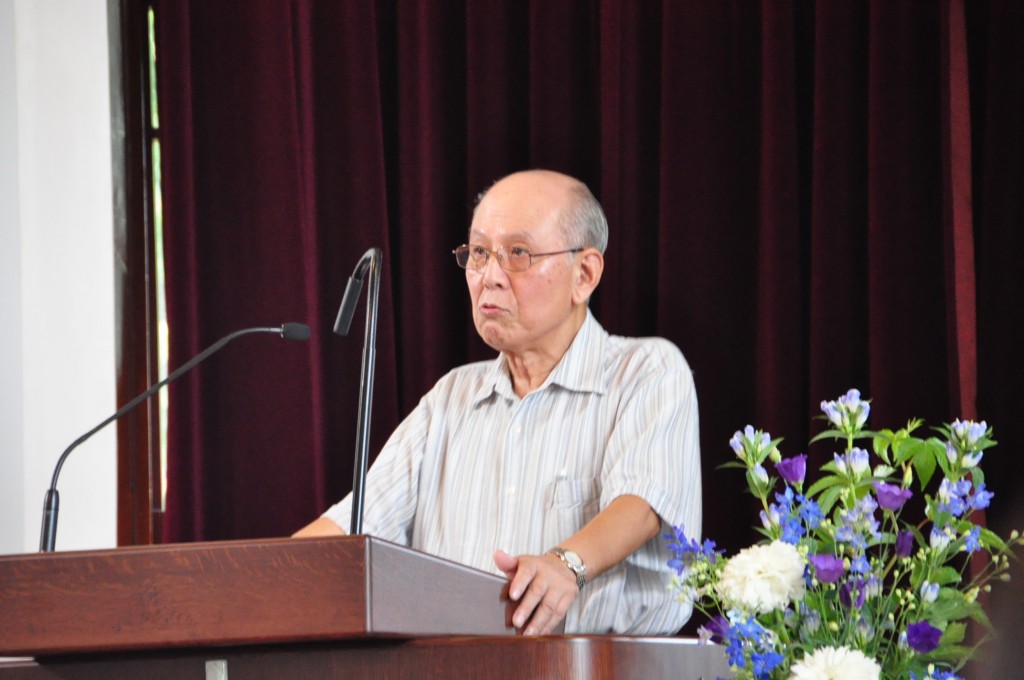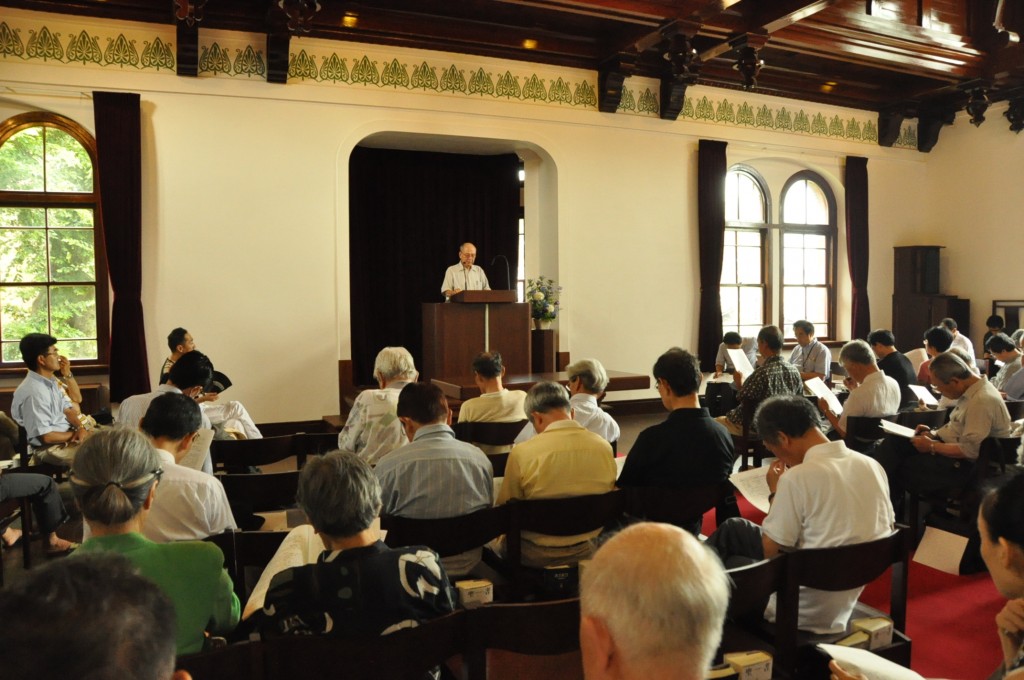Center for Interdisciplinary Study of Monotheistic Religions(CISMOR)Doshisha University
> Public Lectures > Iran’s Suspected Nuclear Development and the Nuclear Nonproliferation RegimePublic Lectures
Open Lecture by Project 2
Iran’s Suspected Nuclear Development and the Nuclear Nonproliferation Regime
| Date: |
2010/07/31 13:00 − 15:00 |
|---|---|
| Place: | Clarke Memorial Hall Chapel, Imadegawa Campus, Doshisha University |
| Lecture: | Shuzo KIMURA, emeritus professor, KOBE University |
| Summary: | |
|
The main theme of the lecture delivered by Dr. Shuzo Kimura is the situation surrounding Iran’s suspected nuclear development. Even before 2002, when Iran’s attempt to develop nuclear weapons was revealed, Iran was carrying out a nuclear program supported by the U.S. (during its monarchial period) as well as by Russia and China (after the Islamic Revolution). Additionally, the country has been a signatory to the NPT since 1970, when the treaty entered into force. In August 2002, Iranian dissidents abroad revealed that Iran was in the process of building two nuclear facilities within its borders without notifying the IAEA, which fueled the suspicion that Iran was taking steps to develop nuclear weapons. Eventually, Iran admitted that they were building nuclear facilities without notifying the IAEA and agreed to allow IAEA inspectors to visit the facilities. As a result of the inspection, it was found that Iran had been conducting uranium enrichment experiments and other nuclear activities without reporting to the IAEA. Accordingly, in September 2003, the IAEA board of governors passed a resolution calling Iran to provide full transparency on its nuclear facilities and activities, as well as to suspend all further uranium enrichment and reprocessing activities. However, Iran was strongly opposed to this resolution on the grounds that the resolution was in violation of the right to pursue nuclear technology for peaceful purposes granted to Iran as a signatory to the NPT. Against this backdrop, the U.K., France, and Germany signed the Tehran Agreement with Iran in October 2003. Under this agreement, Iran agreed to: suspend all uranium enrichment and reprocessing activities on a voluntary basis though retaining the right to nuclear development for peaceful purposes; sign the additional protocol; and take steps to ratify the protocol and provisionally apply the protocol before ratification, while the U.K., France, and Germany agreed to offer economic and technical cooperation to Iran in various sectors, including nuclear development, after Iran would be cleared of suspicion. As it turned out, however, Iran continued uranium enrichment activities, though consenting to the signing of the additional protocol and its provisional application. The IAEA board of governors denounced such behavior by passing four resolutions to condemn Iran, which were met with an aggressive response from Iran and caused tensions to rise rapidly. Then, the U.K., France, and Germany again worked to cope with the situation, and in November 2004, the Paris Agreement was signed, which stipulates that: to build further confidence, Iran will suspend uranium enrichment and reprocessing activities on a voluntary basis; the suspension will be sustained while negotiations proceed on a mutually acceptable agreement regarding long-term arrangements; the agreement will provide objective guarantees that Iran’s nuclear program is exclusively for peaceful purposes; and that firm guarantees will be provided regarding economic and technological cooperation given to Iran and Iran’s security issues. However, since U.S. President George Bush condemned Iran, using the term “axis of evil,” conservatives had gained increased power in Iran, and in June 2005, a hard-line conservative, Mahmoud Ahmadinejad, was elected to the presidency. In August 2005, the U.K., Germany, and France proposed a draft of the long-term agreement in accordance with the Paris Agreement, but Iran expressed dissatisfaction with the draft, declined to accept it, and decided to resume uranium enrichment activities and discontinue the provisional application of the additional protocol, thus nullifying the Paris Agreement. Paying no heed to another resolution of the IAEA board of governors, Iran continued uranium enrichment and reprocessing activities and rejected the application of the additional protocol as well. Under the circumstances, the IAEA board of governors brought this issue to the United Nations Security Council in March 2006. The Security Council called on Iran to take the steps required by the resolution of the IAEA board of governors, which only caused Iran to increase their hostility to the extent that they announced a success in their nuclear enrichment experiments. In July 2006, the Security Council adopted a resolution demanding Iran to suspend all enrichment and reprocessing activities or face sanctions, but Iran did not comply and further expanded enrichment activities. The Security Council passed four resolutions imposing sanctions on Iran between December 2006 and September 2008. In the summer of 2009, Iran requested that the IAEA arrange fuel to be provided to their light-water research reactor, which was expected to soon run out of fuel at the time. Upon this request, the IAEA offered a fuel swap proposal, which aimed to reduce the amount of enriched uranium possessed by Iran. This proposal required that Iran send their domestically produced low-enriched uranium stocks to Russia for further enrichment up to a 20 percent level. Then, Russia, in turn, would send the material to France for conversion into fuel rods for the research reactor. However, Iran declined this proposal in the end and resumed domestic uranium enrichment activities against the criticism of the IAEA board of governors. Despite the growing voice for imposing more sanctions on Iran, Iran made a joint statement with Turkey and Brazil in which they offered a proposal that Iran would send domestically produced low-enriched uranium stocks to Turkey and the U.S., and thereby Russia, France, and the IAEA would supply enriched uranium fuel rods to Iran. What made Turkey and Brazil act jointly with Iran was dissatisfaction among the non-Western NPT signatories toward the “double standards” of the current NPT, which was biased to the interests of Europe and the U.S. In June 2010, the United Nations Security Council adopted another resolution imposing additional sanctions on Iran, which however, did not extend to the energy sector because of the reluctance of China and Russia to tighten sanctions against Iran. On the other hand, the EU, though having been opposed to the U.S. launching sanctions against Iran on their own, agreed to impose sanctions in line with the U.S. These sanctions include: a ban on offering additional support to Iran’s oil and gas industries; the freezing of assets and restrictions on the business activities of specified banks of Iran within the EU; restriction on the entry of Iranian vessels and aircraft into the EU; and a ban on issuing visas to members of the Islamic Revolution Guards Corps and the freezing of their assets. If these sanctions are carried out, they can deal a serious blow to the Iranian economy. Perhaps in order to avoid these sanctions, Iran announced that they notified the IAEA of their intention to resume negotiations on the swap of enriched uranium in a letter addressed to the director general in July 2010. Shunsuke Sugita (Research Assistant, Graduate Student of School of Theology, Doshisha University) |
|
|
*This lecture is given in Japanese. *Admission Free, No reservation necessary *Inquiry: 075-251-3972 (CISMOR) |
|
|
Program(Japanese) Handout(Japanese) |
|

